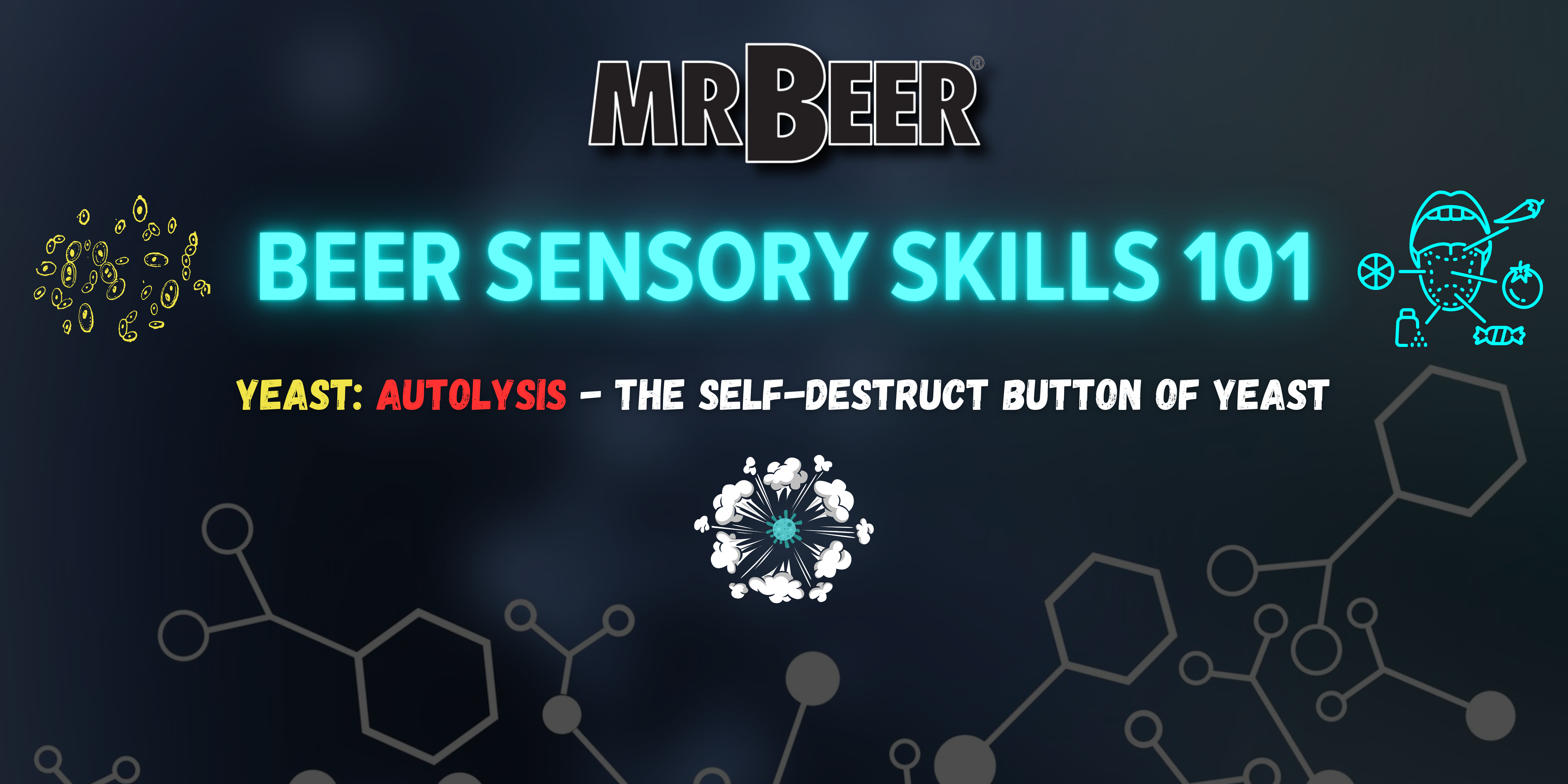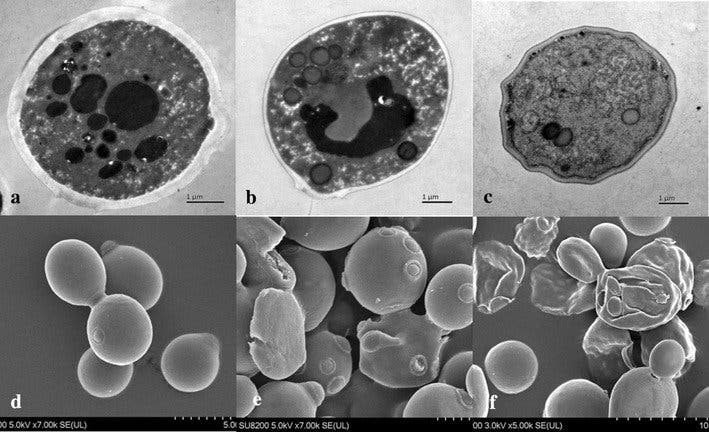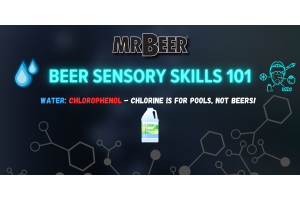Beer Sensory Skills 101 | Yeast | Autolysis

This article is part of a series of lessons and exercises that focus on enhancing your sensory skills to better recognize and address brewing problems. By training your sense of smell, taste, mouthfeel, etc., you will have a better understanding of identifying off-flavors/aromas and their causes, which can greatly assist you when looking for solutions to these problems. This blog series will come in many parts dealing with Yeast, Hops, Malt, Water, Infections/Contaminations, and Miscellaneous issues.
Each lesson includes an exercise in a separate tab to assist you in developing your palate and other senses to better detect these flavors, aromas, etc.
Lesson 1.1- Yeast: Autolysis - The Self-Destruct Button of Yeast
The Chemistry:
Autolysis is a natural process in brewing where yeast cells, despite their resilience, eventually succumb to various stresses during fermentation, conditioning, and storage. This process culminates in the breakdown of vacuolar membranes within the yeast, leading to the release of hydrolytic enzymes that cause the cells to rupture, dispersing their contents into the beer. This phenomenon, essentially self-destruction, has significant implications, primarily in terms of flavor alteration and enzymatic breakdown.
The alteration in flavor, often termed "yeast bite," is characterized by a sharp, bitter taste with meaty and sulfurous undertones, originating from amino acids and nucleotides present in yeast. Elevated yeast concentrations can modify the beer's pH and acidity, further influencing its taste. Additionally, the release of lipids may heighten the risk of rancidity.
Enzymatic breakdown, particularly by proteases leaking from yeast cells, leads to the digestion of proteins in beer. This process notably diminishes head retention, causing foam to dissipate rapidly and giving the impression of flat beer. Furthermore, it may hasten haziness in the beverage. In bottle-conditioned beers, enzymatic action on complex sugars can restart fermentation by residual yeast cells, potentially resulting in over-carbonation and related issues.
Autolysis can be triggered by various factors, including aging, but is exacerbated by poor yeast and beer handling practices. Examples include high temperatures, abrupt temperature changes during pitching or chilling, and osmotic shock from pitching yeast into high-gravity worts. Certain yeast strains are more susceptible to autolysis under conditions such as high alcohol content, carbonation, and acidity, while contamination by bacteria or other yeast species can also hasten the process.
The "Umami":
Remarkably, the meaty and/or cheesy aroma resulting from autolyzed yeast is valued in the food industry as a flavor enhancer, contributing to products ranging from soups and sauces to barbecue-flavored snacks. The yeast extracts known as Marmite and Vegemite, which are very popular in their respective countries of Great Britain and Australia (but not so popular in the US) are made from autolyzed yeast extract that is a byproduct of the brewing industry. The only difference between the 2 is that Vegemite has added vegetables and spices.
Autolyzed yeast is also used as an alternative to Monosodium Glutamate (MSG) because both contain glutamic acid, which is what's responsible for the savory "umami" flavor associated with foods like meat, mushrooms, soy sauce, etc.
Although autolysis flavors are typically undesirable in beer, they are prized in certain wines, such as vintage Champagne, where they contribute to the renowned "sur lie" flavor and aroma. In white wine it can add a creamy, rich depth and sweetness, with caramel, hazelnut, clove, and umami flavors. In sparkling wines it can add bread, cheese, and buttermilk-like aromas. Similarly, aging bottle-conditioned beers on yeast can lead to similar flavor development through autolysis, which, when balanced with other flavors and aromas, can be highly enjoyable.
Avoiding Autolysis:
While autolysis mainly occurs during long periods of aging on the sediment (typically 30 days or longer, though this can vary with yeast strain, age, etc), time isn't the only factor in the autolyzation of your yeast. Improper yeast handling can also promote early yeast autolyzation. The following are possible causes of early autolysis.
• High Temperatures: Exposing yeast to high temperatures, especially above 80°F (27°C), can accelerate autolysis (some Belgian yeasts and german wheat yeasts are an exception as they can ferment into the 90°s). Elevated temperatures increase metabolic activity within yeast cells, leading to faster breakdown of cellular structures and membranes, ultimately promoting autolysis.
• Temperature Fluctuations: Sudden changes in temperature, such as pitching yeast into worts at significantly different temperatures or rapid chilling, can shock the yeast cells. These sudden shifts can disrupt the delicate balance within the cells and weaken their structural integrity, making them more prone to autolysis.
• Osmotic Shock: Pitching yeast into high-gravity worts with high sugar concentrations can subject the yeast cells to osmotic stress. This stress can damage the cell walls and membranes, making them more susceptible to autolysis. It is recommended to use yeast nutrients and fresh, healthy yeast when pitching into high-gravity worts to minimize stress on the cells.
• Poor Repitching Practices: Reusing yeast from one batch to another, especially over multiple cycles, can subject the yeast cells to cumulative stress. Each fermentation cycle introduces new environmental factors and potential contaminants, increasing the likelihood of autolysis over time.
• Presence of Contaminants: Contamination by other microorganisms, such as lactic acid bacteria or wild yeast strains, can induce stress on the brewing yeast. Competition for resources and the production of toxins by contaminants can weaken the yeast cells, making them more prone to autolysis.
• Inherent Sensitivity of Yeast Strains: Some yeast strains may inherently be more sensitive to certain environmental conditions, such as high alcohol levels, carbonation, or acidity. These strains may be predisposed to autolysis under specific brewing conditions. When choosing a yeast strain, be sure it can handle the environment it will be working in.
Ultimately, proper handling and management of yeast throughout the brewing process is essential to minimizing the risk of autolysis and ensure the quality of the final product. This includes controlling fermentation temperatures, minimizing temperature fluctuations, practicing good sanitation to prevent contamination, and using healthy yeast for each batch.

Morphological changes of brewer’s yeast during autolysis in beer brewing. Stationary stage (a, d) is defined at the beginning of post fermentation, stationary anaphase (b, e) is at about one month soaking in the fermented liquor, and afterwards is defined as autolysis stage (c, f).
Detecting Autolysis
Aroma:
• Meaty or Umami Notes: Autolysis can produce savory, meaty aromas reminiscent of broth or cooked meat. These aromas are attributed to the release of amino acids and peptides during yeast cell breakdown.
• Nutty or Toasty Aromas: In some cases, autolysis can contribute nutty or toasty aromas, similar to those found in aged wines or certain bread crusts. These aromas may develop over time as a result of yeast cell breakdown products interacting with other beer components.
• Sulfur Compounds: Autolysis can also release sulfur compounds, which may contribute to aromas described as sulfurous, rotten egg, or "skunky." These aromas are typically considered undesirable and can result from excessive yeast breakdown or poor fermentation conditions.
• Yeasty Aromas: While not necessarily desirable in excess, autolysis can contribute subtle yeasty aromas, which are characteristic of certain beer styles.
Flavor:
• Meaty Flavors: Autolysis can impart meaty flavors to beer, resembling the richness and depth found in broth or cooked meat.
• Umami Notes: Similar to the savory aromas, autolysis can contribute umami notes to the beer's flavor profile, adding complexity and depth.
• Nutty Undertones: Autolysis may introduce nutty undertones to the beer's flavor, reminiscent of roasted nuts or nutty grains.
• Toasty Characteristics: Some beers may develop toasty characteristics as a result of autolysis, akin to the taste of toasted bread or grains.
• Yeasty Impressions: While not necessarily a dominant flavor, autolysis can contribute subtle yeasty impressions, characteristic of certain beer styles.
• Off-Flavors: Excessive autolysis can lead to the development of off-flavors such as diacetyl (buttery) or acetaldehyde (green apple-like), which may detract from the overall beer quality. Lessons on these specific compounds coming soon.
The presence and intensity of these aromas and flavors can vary depending on factors such as yeast strain, fermentation conditions, and aging process. When balanced and integrated into the beer's flavor profile, the flavors resulting from autolysis can contribute positively to its complexity. However, excessive autolysis leading to overpowering or off-flavors is generally considered undesirable in beer.
Sensory Training:
• Taste Different Beers: Sample a variety of beers across different styles, paying attention to their flavor profiles. Look specifically for beers known to exhibit autolyzed yeast characteristics, such as aged or bottle-conditioned beers.
• Conduct Comparative Tastings: Compare beers that have undergone varying degrees of autolysis. Try tasting a fresh beer alongside a similar aged beer to discern the differences in flavor and aroma resulting from autolysis.
• Taste Foods Containing Autolyzed Yeast: Edible yeast extracts such as Marmite or Vegemite (or generic equivalant) contain autolyzed yeast as a main ingredient for the deep umami flavor. While more popular in the UK/AU, they can still be found at many grocery stores or international outlets in the US. Sauces like Worcestershire sauce and A1 sauce are also high in autolyzed yeast. Plant-based meat substitutes also use autolyzed yeast to mimic the savory taste of meat and add depth to the overall flavor.
• Experiment With Food Pairings: Pair beers containing autolyzed yeast flavors with complementary foods to enhance your sensory experience. Notice how certain flavors interact and affect your perception of the beer. Here are some examples:
° Barleywine: This strong ale often exhibits nutty, toasty, and rich flavors, making it a great match for grilled meats, mushroom risotto, and dark chocolate desserts.
° Belgian Tripel: With its complex and spicy yeast character, Belgian Tripel pairs well with cheeses like Gouda or Swiss, as well as roasted root vegetables and charcuterie boards.
° Bière de Garde: This French farmhouse ale can have nutty, toasty, and earthy flavors, making it an excellent companion to grilled meats, mushroom risotto, and dark chocolate desserts.
° Aged Imperial Stout: Aged stouts can develop nutty, toasty, umami, and rich flavors over time. They pair nicely with dark chocolate desserts, grilled meats, and charcuterie boards.
By actively engaging in tasting exercises, expanding your beer knowledge, and seeking feedback from others, you can gradually train your palate to detect autolyzed yeast flavors in beer with greater precision and confidence.
Recommended Beers For This Lesson
Autolysis, when controlled and balanced, can contribute positively to certain beer styles, adding complexity and depth to their flavor profiles. Here are some beer styles where autolysis is often considered acceptable or even desirable:
It's important to note that while autolysis can enhance the flavor profile of these beer styles when properly managed, excessive autolysis leading to off-flavors or overpowering aromas is generally undesirable. Brewers must carefully monitor and control the aging process to achieve the desired balance of flavors and ensure high-quality beer.





